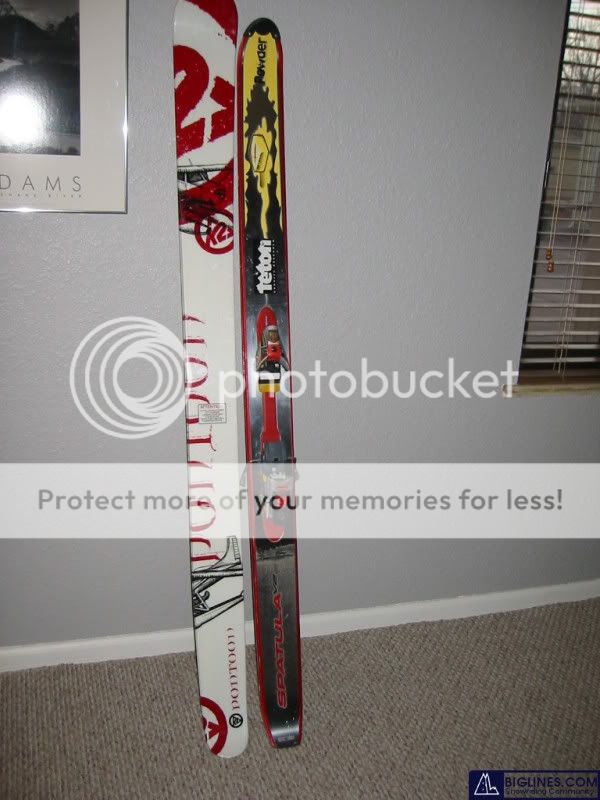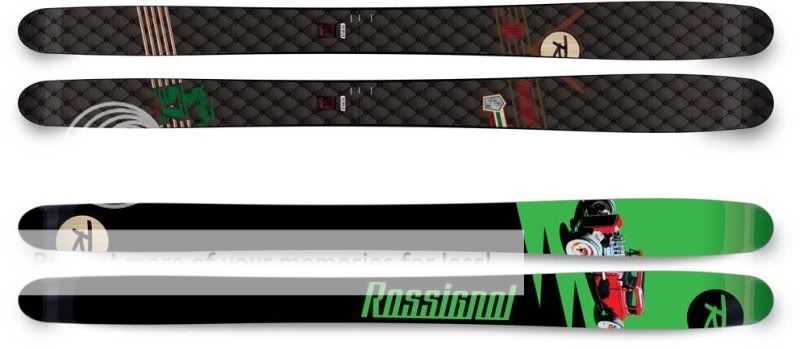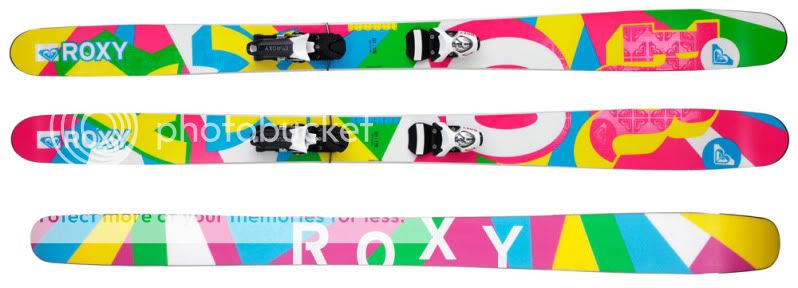tradygirl
Ski Diva Extraordinaire
Big, Fat Powder Ski Basics, Part 1: Why go big?
So you want to ski powder like Sage, do ya? Sick of being left wallowing while your friends smoke you down that powder field yet again? Well here are the basics to help you through demoing and purchasing your next pair of fatties so you can start slaying the pow too!
First of all, whatever I say here will probably be blown out of the water by the end of next season. Ski designers are getting extremely creative and innovative with their designs and I’m sure there are even more fun breakthroughs in the pipeline. So, here's a quick primer about what elements are driving the new generation of powder skis.
Camber
In the early 2000’s Shane McConkey shocked the skiing world with the unveiling of the Volant Spatula. The ski introduced a radical new design that would change powder skiing forever. Since then, the term “reverse camber” has been thrown around a whole bunch. So what does it mean?
Camber is amount of fore-aft curvature designed into the ski. Conventional camber is dome-shaped, which means if the ski is on the ground un-weighted, the waist of the ski will be higher than the tip and tail. Conventional camber is what gives you so much control on groomers – the curvature allows the full length of the ski edge to stay in contact as the ski compresses underfoot during a turn. Reverse camber is therefore bowl-shaped, which means that if the ski is on the ground un-weighted, the tip and tail will be higher than the waist. This means that since the tips are already higher than the waist, as you weight the ski into a turn you’ll lose even more edge contact! This is the reason that full reverse camber may not be the best choice for groomers. It feels like riding on two saucers. Rockered is another term being thrown around, which is usually referring to reverse camber at only the tip or tail. Early rise is yet another term that describes moving the contact point of the snow backwards towards your boot. For instance, if you laid the ski flat, the tip loses contact with the ground sooner than a typical ski.
So traditional camber skis are made to keep the tip and tail of your ski in contact with the snow, right? What’s the hardest part about powder skiing? Tip dive! Reverse camber solves the problem of having to lean way back in order to keep from kissing your tips and doing a powder somersault. The tips float no matter what you do! The other BIG benefit of reverse camber is lack of “edge hooking” in variable snow. Reverse camber skis cut through heavy snow, crusts, chop, and wind blown almost like powder.
Side cut
Simply put, side cut is the difference in width of the waist compared to the tips of the ski. Side cut radius is the radius of the circle that would fit within the curvature of the side of the ski. Larger side cut = smaller radius. The amount of side cut a ski has will change the turning radius of a ski. As a ski decambers when weighted in a turn, the amount of side cut will determine how much the ski will decamber before the edges engage under the foot. More side cut = more decamber = smaller turning radius.
However, let’s consider powder skiing. What’s the last thing you want to do? Sink. Imagine that super side cut ski you were just ripping groomers on. It’s made to decamber a lot to allow your edges to stay engaged in a tight turn. So what happens in the powder? You weight the ski and your feet sink at the point where your ski is the narrowest. Less side cut = less decamber = less sinkage!
So this gets us into reverse side cut, which was dramatically displayed by the Spatula. A fatter underfoot and tapered tips will keep you on top of the snow while also cutting through snow like a hot knife through butter.
Width
Only a few years ago, a ski that was 100mm underfoot was considered overkill, but we are now seeing skis 120+! The difference is the camber. Make a traditionally cut and cambered ski 120mm wide - although it may float better due to shear surface area, the ski is still designed for tip dive. Now make a 120mm ski on a reverse camber platform, and there ya go, skiing like Jeremy Nobis. The drawback to going wider and wider for either reverse or traditional camber is that the ski gets harder and harder to get on edge. Going heli-skiing? Go fat with minimal sidecut - no worries about edging! Skiing at the resort every weekend? You may want to think a little bit harder about the design you choose.
Length
Again, new ski designs are destroying the old sizing rules. Ski length is now all about “running length”, or how much of the ski will be in contact with the snow while turning on a groomer. Traditional skis are made to keep as much of the ski as possible in contact to increase control and speed on groomed runs. However, powder skis with reverse camber designs will only have a fraction of the length of the ski in contact with the snow during a groomer turn. This effectively makes the ski feel shorter! The beauty of this is that you can easily handle a bigger ski that will float even better in the pow.
Next: So why all the different designs?
So you want to ski powder like Sage, do ya? Sick of being left wallowing while your friends smoke you down that powder field yet again? Well here are the basics to help you through demoing and purchasing your next pair of fatties so you can start slaying the pow too!
First of all, whatever I say here will probably be blown out of the water by the end of next season. Ski designers are getting extremely creative and innovative with their designs and I’m sure there are even more fun breakthroughs in the pipeline. So, here's a quick primer about what elements are driving the new generation of powder skis.
Camber
In the early 2000’s Shane McConkey shocked the skiing world with the unveiling of the Volant Spatula. The ski introduced a radical new design that would change powder skiing forever. Since then, the term “reverse camber” has been thrown around a whole bunch. So what does it mean?
Camber is amount of fore-aft curvature designed into the ski. Conventional camber is dome-shaped, which means if the ski is on the ground un-weighted, the waist of the ski will be higher than the tip and tail. Conventional camber is what gives you so much control on groomers – the curvature allows the full length of the ski edge to stay in contact as the ski compresses underfoot during a turn. Reverse camber is therefore bowl-shaped, which means that if the ski is on the ground un-weighted, the tip and tail will be higher than the waist. This means that since the tips are already higher than the waist, as you weight the ski into a turn you’ll lose even more edge contact! This is the reason that full reverse camber may not be the best choice for groomers. It feels like riding on two saucers. Rockered is another term being thrown around, which is usually referring to reverse camber at only the tip or tail. Early rise is yet another term that describes moving the contact point of the snow backwards towards your boot. For instance, if you laid the ski flat, the tip loses contact with the ground sooner than a typical ski.
So traditional camber skis are made to keep the tip and tail of your ski in contact with the snow, right? What’s the hardest part about powder skiing? Tip dive! Reverse camber solves the problem of having to lean way back in order to keep from kissing your tips and doing a powder somersault. The tips float no matter what you do! The other BIG benefit of reverse camber is lack of “edge hooking” in variable snow. Reverse camber skis cut through heavy snow, crusts, chop, and wind blown almost like powder.
Side cut
Simply put, side cut is the difference in width of the waist compared to the tips of the ski. Side cut radius is the radius of the circle that would fit within the curvature of the side of the ski. Larger side cut = smaller radius. The amount of side cut a ski has will change the turning radius of a ski. As a ski decambers when weighted in a turn, the amount of side cut will determine how much the ski will decamber before the edges engage under the foot. More side cut = more decamber = smaller turning radius.
However, let’s consider powder skiing. What’s the last thing you want to do? Sink. Imagine that super side cut ski you were just ripping groomers on. It’s made to decamber a lot to allow your edges to stay engaged in a tight turn. So what happens in the powder? You weight the ski and your feet sink at the point where your ski is the narrowest. Less side cut = less decamber = less sinkage!
So this gets us into reverse side cut, which was dramatically displayed by the Spatula. A fatter underfoot and tapered tips will keep you on top of the snow while also cutting through snow like a hot knife through butter.
Width
Only a few years ago, a ski that was 100mm underfoot was considered overkill, but we are now seeing skis 120+! The difference is the camber. Make a traditionally cut and cambered ski 120mm wide - although it may float better due to shear surface area, the ski is still designed for tip dive. Now make a 120mm ski on a reverse camber platform, and there ya go, skiing like Jeremy Nobis. The drawback to going wider and wider for either reverse or traditional camber is that the ski gets harder and harder to get on edge. Going heli-skiing? Go fat with minimal sidecut - no worries about edging! Skiing at the resort every weekend? You may want to think a little bit harder about the design you choose.
Length
Again, new ski designs are destroying the old sizing rules. Ski length is now all about “running length”, or how much of the ski will be in contact with the snow while turning on a groomer. Traditional skis are made to keep as much of the ski as possible in contact to increase control and speed on groomed runs. However, powder skis with reverse camber designs will only have a fraction of the length of the ski in contact with the snow during a groomer turn. This effectively makes the ski feel shorter! The beauty of this is that you can easily handle a bigger ski that will float even better in the pow.
Next: So why all the different designs?










